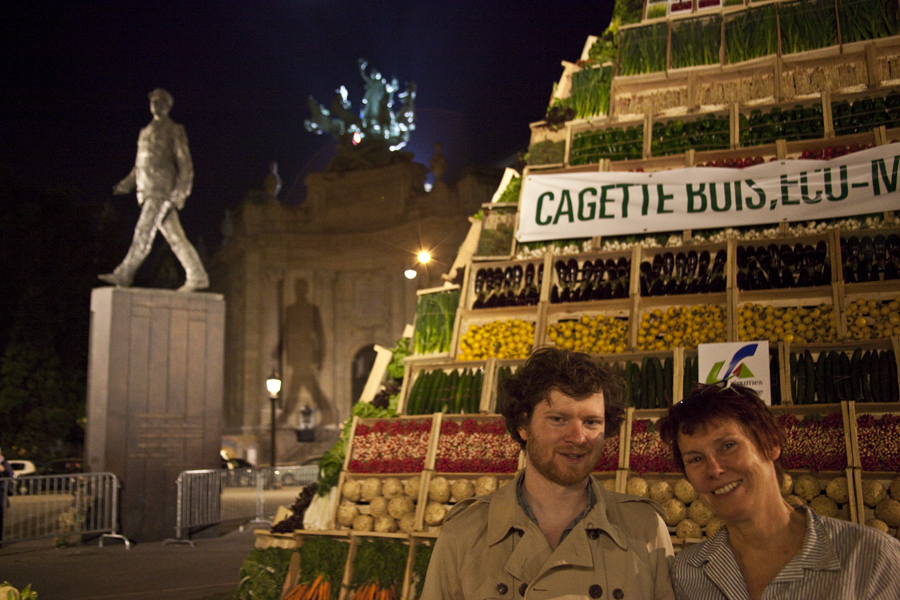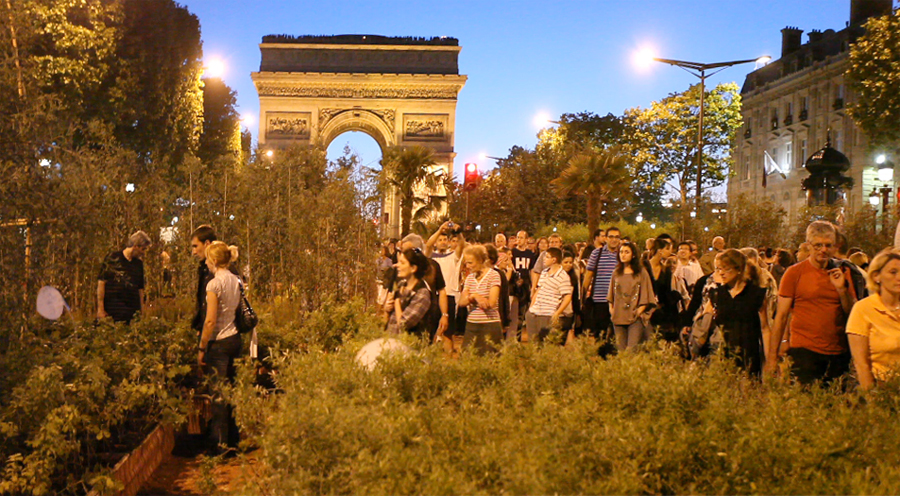Gad Weil, creator and director of street art, who 20 years ago turned the Champs-Elysées into a huge field of corn, conceived “Nature Capitale as a new green monumental and festive work. Working with landscape artist Laurence Medioni, Weil had the avenue closed to traffic and the 3-hectare space filled with plots of more than 150 varieties of plants, a testimony to biodiversity in France, to produce a living green mosaic the public could stroll through, stop and admire nature. The Jeunes Agriculteurs (Young Farmers) union, representing 55,000 farmers under the age of 35, installed mini-fields the size of six soccer pitches along a km stretch of the avenue to showcase farm production from lavender to livestock. This ephemeral botanical work allowed agricultural and forestry professionals involved in the installation to not only put the spotlight on “Nature fashioned by Man” but also on the fragile balance between human beings and their environment.
The two-day event, timed to coincide with a holiday weekend, attracted about 2 million people. The team who transformed the Champs-Elysees in Paris into a strip of farmland at the weekend to heighten awareness of the agriculture sector plan to take the concept overseas, the project's designer said. "We want to take "Nature Capitale" to New York (to work with) the farmers and woodmen of New York state, to Istanbul with their farmers, Berlin and other cities who want to welcome us," Gad Weil, who created the concept, told France Info radio. ( I wonder if it will happen in Melbourne)
Deciding to arrive at the Nature Capitale installation on dusk, we (Tess, Ned, Gabe and Lloyd) emerged from the dark depths of the metro to an enchanting landscape. Despite the seductive scene of the immense Arc de Triomphe gold lit against the ambient Parisian twilight, the compelling swath of luxurious green of Nature Capitale turned us around 180 degrees and drew us in for a walk through the transitory forest. It was an enthralling sea of people and plants.
|
The audience was obviously as enchanted as we were. The plants had been grown in boxes about 3m square and placed with narrow walk-ways between them to allow people to walk freely across and up and down the strip. The diversity was huge; crop plants included wheat, carrots, lettuce, pumpkins, zucchini, tobacco, bananas, pineapples etc. Trees of every description lined the edges.
At the end of our walk were countless stalls by farmers from various areas offering samples of their produce. By the time we traversed the site to this point, it was near closing and the Jeunes Agriculteurs were in full party mode, drinking wine, beer, dancing singing, laughing etc. Conversing with some this was their first tip to Paris and they felt they had succeeded in touching the Parisian hearts with a little bit of natural soul from the French country side. It was a means for them to reach out to the Capitale.
Farmers angered by a sharp fall in revenues have used Paris to stage protests, including a tractor-led demonstration and a protest in front of the presidential palace in December. The weekend event was reminiscent of a display 20 years ago in which farmers on combine harvesters cut a field of grain on the Champs-Elysees. French President Nicolas Sarkozy and his wife Carla made a surprise visit to the event on Monday, partly to ease tensions with the farming community. Such a visit "is always fun, but what's needed is that he listens to us and our demands," said one farmer. "The first message was to gather people around road art for something that concerns all the French ... the link man has with nature and to make a huge crowd smile with no incidents despite such a difficult time in the world," Weil said.
French farmers have urged the European Union to maintain a strong regulatory framework for farming as the bloc debates the future of its Common Agricultural Policy, under which France receives the most subsidies out of the 27 EU countries. |


|